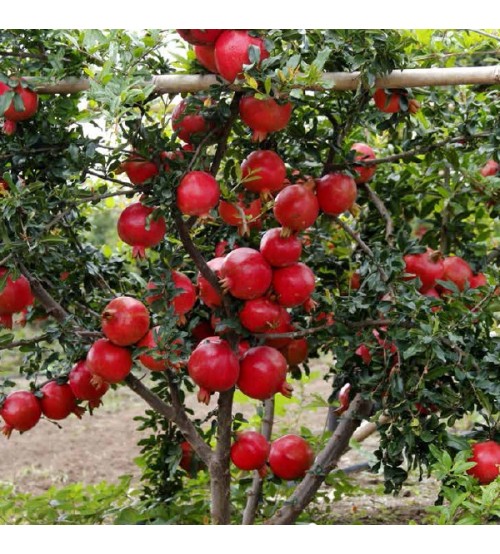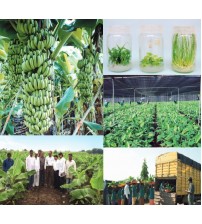Jain Tissue culture Pomegranate
Climate
• It thrives best under hot dry summer and cold winter provided irrigation facilities are available.
• Rainfall above 500-750 mm is not suitable for fruiting of pomegranate.
• Humidity lowers the quality and proliferate diseases.
• It is fairly tolerant to low temperatures.
• However for proper fruit development, a temperature of 35-38 °C is necessary.
Soil
• Pomegranate is a very hardy crop and thrives well in shallow rocky soils.
• It grows well in a range of pH , 6-8; and can tolerate alkalinity and salinity
• However best results are obtained in deep, heavy loam and well drained soils.
• The incidence of diseases (bacterial and fungal) under low fertility conditions.
• It is sensitive to soil moisture fluctuation causing fruit cracking.
Land preparation for TC pomegranate
• It is recommended to plant TC pomegranate saplings either on flat or raised beds.
• Pits are dug at recommended spacings; pits are of 1’x1’x1’ for light loamy soils; 2’x2’x2’ for medium soils; and 3’x3’x 3’ for rocky or stony soils.
• Raised beds are compulsory for heavy soils; the width of the bed is 90 cm; the centre to centre distance of the beds will be 3 m. (DRAW two beds)
• The pits dug at the crest of the raised bed will be 1’x1’1’.
Plant spacing
• Spacing of TC pomegranate depends on soil type and climate. Normal spacing is 15’ x 10’ accommodating 299 trees/ac.
• In Precision farming, 12’ x 12’ (311 trees/ac), 10’x10’ (449 trees/ac)and 7’ (row-row) x 10’(plant-plant) (641 trees/ac) are recommended based on the soil type.
• 7’x10 spacing gives ultra high density with 641 trees per acre . The canopy of this UHDP population is maintained by pruning every year to eliminate plant to plant competition.
- The conventional planting material of pomegranate is the air- layered saplings from existing mature trees. Production of this sapling brings with it all the diseases and other characteristics of the mother plant. In a way the disease transmission to the new generation of planting material is inevitable.
- Large number of mother plants is required to produce sufficient saplings; the maximum number of air layers per tree is 100-150.
- Added to these disadvantages is the very low survival rate of air layered saplings when planted in the field. This is mainly because of the manual handling of the process of air layering and removal of the layered saplings from the mother plant. Additionally, the poor selection of branches for air layering adds to the low survival after planting.
- Air layered saplings are not uniform in growth and fruiting characters. Similarly non-uniformity arises because of the large number of mother trees used for air layering.
- The turn over period (time duration from mature mother plant to the fruiting of air layered daughter plant) is very long in the conventional method of sapling production (36 months for the air layered sapling to come to fruition).
- These disadvantages cause loss of time, productivity and quality in Pomegranate production systems.
- Jain Irrigation introduced TC technology into Pomegranate to overcome these disadvantages.
- TC plants are produced from tissue taken from disease free elite mother plants grown in protected environment thus making the planting material (TC originated) totally disease germ free. The mother tissue is indexed for both bacterial and fungal organisms to ensure that the TC plants are not carrying any disease agents.
- TC production requires very few healthy mother plants to produce large number of saplings; for example, starter tissues from one mother plant can produce up to a million (10 lakh) TC plants.
- The field survival of these TC plants is very high (99%).
- TC planting material offers a uniform and faster growth rate compared to conventional air layered saplings.
- TC pomegranate will flower and fruit in 18 months after planting.
- TC plants produce more secondary and tertiary branches and develop a bigger canopy much faster giving rise tomore shoot points for flowering.
- These trees flower early (18 months) and produce more fruits per tree per season.
- The fruits are bigger in size with attractive rind colour.
Climate
• It thrives best under hot dry summer and cold winter provided irrigation facilities are available.
• Rainfall above 500-750 mm is not suitable for fruiting of pomegranate.
• Humidity lowers the quality and proliferate diseases.
• It is fairly tolerant to low temperatures.
• However for proper fruit development, a temperature of 35-38 °C is necessary.
Soil
• Pomegranate is a very hardy crop and thrives well in shallow rocky soils.
• It grows well in a range of pH , 6-8; and can tolerate alkalinity and salinity
• However best results are obtained in deep, heavy loam and well drained soils.
• The incidence of diseases (bacterial and fungal) under low fertility conditions.
• It is sensitive to soil moisture fluctuation causing fruit cracking.
Land preparation for TC pomegranate
• It is recommended to plant TC pomegranate saplings either on flat or raised beds.
• Pits are dug at recommended spacings; pits are of 1’x1’x1’ for light loamy soils; 2’x2’x2’ for medium soils; and 3’x3’x 3’ for rocky or stony soils.
• Raised beds are compulsory for heavy soils; the width of the bed is 90 cm; the centre to centre distance of the beds will be 3 m. (DRAW two beds)
• The pits dug at the crest of the raised bed will be 1’x1’1’.
Plant spacing
• Spacing of TC pomegranate depends on soil type and climate. Normal spacing is 15’ x 10’ accommodating 299 trees/ac.
• In Precision farming, 12’ x 12’ (311 trees/ac), 10’x10’ (449 trees/ac)and 7’ (row-row) x 10’(plant-plant) (641 trees/ac) are recommended based on the soil type.
• 7’x10 spacing gives ultra high density with 641 trees per acre . The canopy of this UHDP population is maintained by pruning every year to eliminate plant to plant competition.





-202x224.JPG)